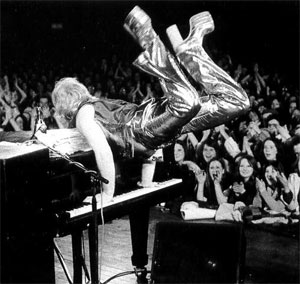As music fans, I think we all remember the first time that we came across certain albums. On one particular day at the local Goodwill thrift store, I was thumbing through the stacks of vinyl and came across a battered copy of Elton John’s 11-17-70. One look at the cover, and I knew that I’d have to take this one home. My Elton familiarity at this point was mainly with ’80s Elton, and he’d always been on my list of artists to further investigate, and 11-17-70 was my chance to take a closer look. On that afternoon, I bought two Elton albums, 11-17-70 and Goodbye Yellow Brick Road, for a total price of 75 cents. Tuition for a young scholar studying stacks of vinyl doesn’t get much cheaper than that!
Recorded live at A&R Studios in front of a small studio audience, 11-17-70 originated as a concert broadcast for WABC-FM. Bootlegs of the broadcast forced an official (although incomplete) release of the broadcast. To date, 11-17-70 remains one of my favorite live documents of any artist, right up there with the infamous bootleg of Billy Joel’s performance at C.W. Post. Both recordings capture lightning in a bottle, landmark moments caught on tape from two artists that were only beginning to share their musical talents with the world.
 When Wolfgang’s Vault expanded their offerings of shows to stream/download this past November, the newly added Elton John performance recorded in Cleveland was one of the first things that I had to listen to, as soon as I saw it. Recorded a week after the classic WABC broadcast, John and his band made their way to Cleveland to play a slightly larger venue, the cavernous Music Hall. At this point, they were merely a trio: Elton on piano, Nigel Olsson on drums, and Dee Murray on bass guitar. Elton’s classic lineup would finally come together officially a couple of years later when guitarist Davey Johnstone joined the group.
When Wolfgang’s Vault expanded their offerings of shows to stream/download this past November, the newly added Elton John performance recorded in Cleveland was one of the first things that I had to listen to, as soon as I saw it. Recorded a week after the classic WABC broadcast, John and his band made their way to Cleveland to play a slightly larger venue, the cavernous Music Hall. At this point, they were merely a trio: Elton on piano, Nigel Olsson on drums, and Dee Murray on bass guitar. Elton’s classic lineup would finally come together officially a couple of years later when guitarist Davey Johnstone joined the group.
Elton made his U.S. debut with a series of shows at the Troubadour in Los Angeles in August of 1970, and after seeing the first night of the Los Angeles run, music critic Robert Hilburn branded John as someone who would be “one of rock’s biggest and most important stars.” John came to Cleveland on the eve of the U.S. release for his second album Tumbleweed Connection (an album that had already been released in the UK), which would come out the following month. One can easily imagine what it must have been like to have been in the audience for those early shows, being blown away as Hilburn was by what he saw on stage.
The pairing of “Take Me To The Pilot/Sixty Years On” in this Cleveland setlist remains a centerpiece of John’s set, as it was on 11-17-70. The first time that I heard this combo on 11-17-70, I had to take the needle back to the beginning to believe what I was hearing. Compared to the later material that I was used to, i.e. “Sad Songs (Say So Much),” “I’m Still Standing,” etc; “Take Me To The Pilot” was epic, especially considering the lyrics:
Through a glass eye your throne
Is the one danger zone
Take me to the pilot for control
Take me to the pilot of your soul
Whammy! My mind had been blown wide open, and I was officially on board as an Elton John fan. You can hear a similar disbelief from the Cleveland audience as John and his band put the closing touches on the combo. I think it’s safe to say that at that point, anybody who had been on the fence about this Elton John guy, they were probably converted, but Elton still had a couple of tricks up his sleeve. The first one was a barnstorming cover of “Honky Tonk Women,” slyly introduced as “HTW,” a song that had been “written by a couple of people that have written a couple of good songs.” Saving the best for last, John pulls out the secret weapon – an eighteen minute medley featuring Tumbleweed Connection‘s “Burn Down The Mission,” “Can I Put You On” (eventually released in 1971 on the Friends soundtrack) and a Beatles cover of “Get Back” that seemingly was custom-fit for Elton’s musical destruction, a fine end cap on the main part of the set.
While this might not be the most pristine sounding show in the Vault, with this particular show it’s all about the performance and the chance to hear an audio document of Elton John in 1970 that unlike the officially released material, hasn’t been doctored or remixed. Warts and all, the Cleveland show gives you a front row ticket to be a part of Elton’s inaugaral trip to the United States. The production (and costume changes) would eventually grow with subsequent tours, but for one night in Cleveland, it took only three people and their respective instruments to get the job done.




Comments